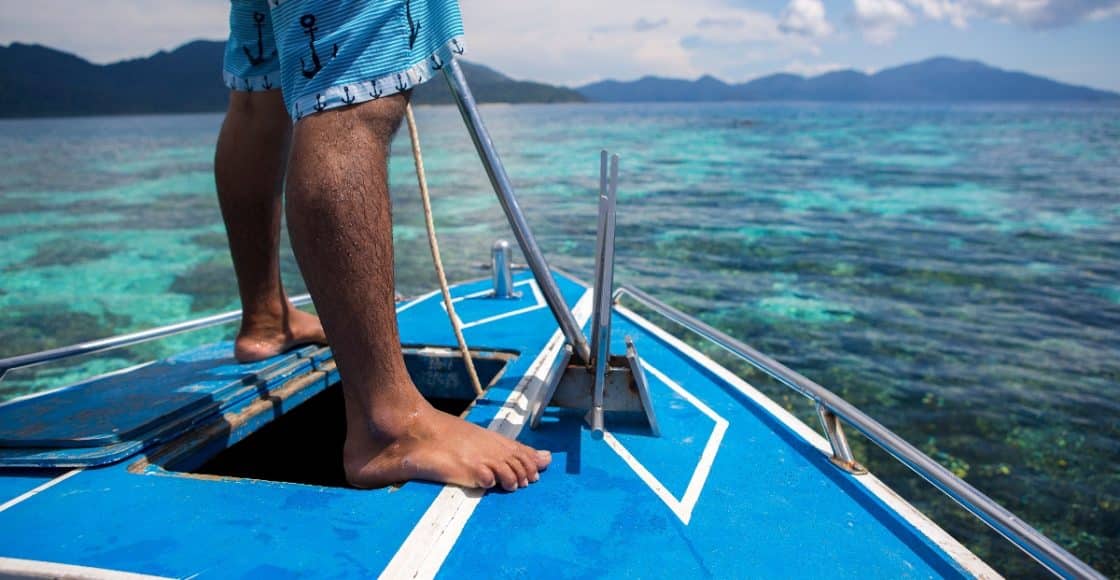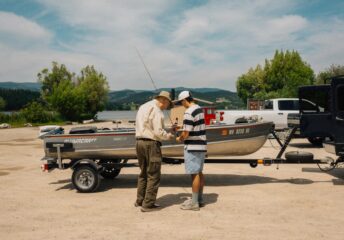Anchoring: How Much Chain Do I Need?
Last Updated on February 6, 2024 by Boatsetter Team
Anchoring a boat is pretty easy once you know the steps and practice. Even then, people get overwhelmed with doubt particularly with this question: How much chain do I need? Here are some tips to boost your confidence when you’re sticking yourself to the ground.
Post summary:
- Calculating your anchor scope
- Rode type matters
- Allowing for swinging room when anchoring
- Counting out rode
- Quick anchoring tips
Get boating experience with Boatsetter
Calculating your anchor scope
The scope is the ratio of the length of the anchor rode you will want to pay out to the depth of the water. Anchor rode is what connects the anchor to the boat. What connects the anchor to the boat may be rope, chain, or a combination of the two. The more rode the smaller the angle of the shank to the bottom surface which helps the anchor remain dug in and secure.
The length of rode/water depth ratio or “scope” you’ll need depends on the size and type of boat, size and type of anchor and rode, the holding ground, the conditions including weather and sea state, and the length of your stay in the anchorage. The general rule is a ratio of 7:1, or 7 times the rode to the depth of the water. So, if you anchor in 20 feet, you’ll need 140 feet of rode. Now for the exceptions.
If you’re dropping anchor for lunchtime, the weather is calm, you’re on a small runabout and you’ll be aboard the whole time, a scope of 4:1 may suffice. In 20 feet of water, you’ll need 80 feet of rode. However, let’s say you’re anchoring a large boat overnight, want to leave the boat, or the weather is rough with heavy wind, sea state and current. Then you should opt for greater scope (say 7:1) and let out more rode to keep the weight low and the anchor snug.
Rode type matters
An anchor rode made up entirely of chain is heavier than all line or a chain-line rode, so less may be needed. If you have a large anchor for the size of the boat and 0.5 to 0.75 chain, the combined weight will help you stay put. If you have a small amount of chain spliced to rope rode, opt for scope with a larger ratio. If in doubt and when you have the swinging room, more scope or chain is better.
READ MORE: Boat Anchor Types: A Complete Guide
Allowing for swinging room when anchoring
The optimal amount of chain will depend heavily on your swinging room. Swinging room is the movement of the boat around the anchor as the wind and current shift. If you’re in a tight anchorage with nearby boats, docks or rocks, you may not have enough space for a proper amount of scope in which case, you should consider a safer area. Pro tip: Pick a spot with swinging room in all directions.
Sailboats, powerboats and sail-power catamarans have different structures above and below the waterline and will move differently from one another. A powerboat is more likely to move with the wind since it has a higher freeboard while a sailboat will react more to current given its deep keel. Catamarans with two hulls are their own animal entirely. When anchoring, keep in mind how other boats around you are likely to swing in changing conditions. This will affect both where you anchor and how much scope you use.
To limit the swinging room, use two anchors. You can anchor bow and stern by dropping the bow anchor and motoring back, then dropping the stern anchor and motoring forward until both are set and the boat is snug in the middle, effectively cutting the scope potentially in half. Or you can use two anchors off the bow about 90 degrees apart in a Bahamian Moor which is very effective in narrow channels or rivers.
Counting out rode
Many times, the chain isn’t marked so it’s hard to gage how much is going out. Watch your windlass for the first few feet and estimate how fast the chain is leaving the boat. Most windlasses will put out a foot of chain per second. Just count how long the windlass turns and you’ll be in the ballpark of how much chain has gone out. When anchoring a small boat by hand with line, take the line around a cleat to minimize chafe on the hands as it slips down and estimate how much you’re putting out manually.
Anchors aweigh: Quick tips
- Go slow and give the boat and anchor time to settle.
- If the anchor is dragging (or not holding), you’ll need to retrieve the entire anchor and try again (Pro tip: You’ll see the anchor chain go taught and then loose or you’ll see it jerk as the boat moves aft with the engine or wind).
- Don’t crowd anyone who is already anchored, be careful to not drift down on boats behind you, and if everyone is on two anchors (fore and aft) then you need to be prepared to do the same.
- Don’t anchor near set moorings because those boats won’t swing as much as you will on a long scope.
- Be prepared to move if you’re making anyone unsafe or uncomfortable.
Anchoring isn’t as difficult as our mind’s make it out to be. Just follow the steps, apply the anchoring tips, and enjoy your boat day.
Watch this video on anchoring a boat
About us
Boatsetter is the go-to app for boat rentals and on-water experiences. Whatever the adventure, we’ve got a boat for that—Set sail, start the party, go yachting, make your trophy catch, and hone your watersports skills! Download the Boatsetter app (App Store | Google Play). Make sure to follow @boatsetter on Instagram, and tag us in all your boat day pictures for the chance to be featured.
Rent. List. Share—Only at Boatsetter

Boatsetter empowers people to explore with confidence by showing them a world of possibility on the water. Rent a boat, list your boat, or become a Boatsetter captain today.










